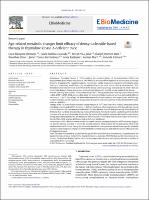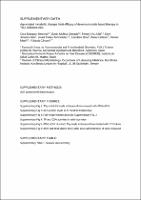| dc.contributor | Vall d'Hebron Barcelona Hospital Campus |
| dc.contributor.author | Blazquez Bermejo, Cora |
| dc.contributor.author | Molina Granada, David |
| dc.contributor.author | Vila Julià, Ferran |
| dc.contributor.author | Jiménez Heis, Daniel |
| dc.contributor.author | Zhou, Xiaoshan |
| dc.contributor.author | Torres Torronteras, Javier |
| dc.contributor.author | Karlsson, Anna |
| dc.contributor.author | Martí Seves, Ramón |
| dc.contributor.author | Cámara Navarro, Yolanda |
| dc.date.accessioned | 2020-02-17T13:17:02Z |
| dc.date.available | 2020-02-17T13:17:02Z |
| dc.date.issued | 2019-07-24 |
| dc.identifier.citation | Blázquez-Bermejo C, Molina-Granada D, Vila-Julià F, Jiménez-Heis D, Zhou X, Torres-Torronteras J, et al. Age-related metabolic changes limit efficacy of deoxynucleoside-based therapy in thymidine kinase 2-deficient mice. EBioMedicine. 2019 Aug 1;46:342–55. |
| dc.identifier.issn | 2352-3964 |
| dc.identifier.uri | https://hdl.handle.net/11351/4644 |
| dc.description | Deoxycytidine; Deoxynucleoside therapy; Encephalomyopathy |
| dc.description.abstract | BACKGROUND:
Thymidine kinase 2 (TK2) catalyses the phosphorylation of deoxythymidine (dThd) and deoxycytidine (dCtd) within mitochondria. TK2 deficiency leads to mtDNA depletion or accumulation of multiple deletions. In patients, TK2 mutations typically manifest as a rapidly progressive myopathy with infantile onset, leading to respiratory insufficiency and encephalopathy in the most severe clinical presentations. TK2-deficient mice develop the most severe form of the disease and die at average postnatal day 16. dThd+dCtd administration delayed disease progression and expanded lifespan of a knockin murine model of the disease.
METHODS:
We daily administered TK2 knockout mice (Tk2KO) from postnatal day 4 with equimolar doses of dThd+dCtd, dTMP+dCMP, dThd alone or dCtd alone. We monitored body weight and survival and studied different variables at 12 or 29 days of age. We determined metabolite levels in plasma and target tissues, mtDNA copy number in tissues, and the expression and activities of enzymes with a relevant role in mitochondrial dNTP anabolism or catabolism.
FINDINGS:
dThd+dCtd treatment extended average lifespan of Tk2KO mice from 16 to 34 days, attenuated growth retardation, and rescued mtDNA depletion in skeletal muscle and other target tissues of 12-day-old mice, except in brain. However, the treatment was ineffective in 29-day-old mice that still died prematurely. Bioavailability of dThd and dCtd markedly decreased during mouse development. Activity of enzymes catabolizing dThd and dCtd increased with age in small intestine. Conversely, the activity of the anabolic enzymes decreased in target tissues during mouse development. We also found that administration of dThd alone had the same impact on survival to that of dThd+dCtd, whereas dCtd alone had no influence on lifespan.
INTERPRETATION:
dThd+dCtd treatment recruits alternative cytosolic salvage pathways for dNTP synthesis, suggesting that this therapy would be of benefit for any Tk2 mutation. dThd accounts for the therapeutic effect of the combined treatment in mice. During the first weeks after birth, mice experience marked tissue-specific metabolic regulations and ontogenetic changes in dNTP metabolism-related enzymes that limit therapeutic efficacy to early developmental stages. |
| dc.language.iso | eng |
| dc.publisher | Elsevier |
| dc.relation.ispartofseries | Ebiomedicine;46 |
| dc.rights | Attribution-NonCommercial-NoDerivatives 4.0 International |
| dc.rights.uri | http://creativecommons.org/licenses/by-nc-nd/4.0/ |
| dc.source | Scientia |
| dc.subject | Timidina |
| dc.subject | ADN mitocondrial |
| dc.subject | Longevitat |
| dc.subject.mesh | Thymidine Kinase |
| dc.subject.mesh | DNA, Mitochondrial |
| dc.subject.mesh | Longevity |
| dc.title | Age-related metabolic changes limit efficacy of deoxynucleoside-based therapy in thymidine kinase 2-deficient mice |
| dc.type | info:eu-repo/semantics/article |
| dc.identifier.doi | 10.1016/j.ebiom.2019.07.042 |
| dc.subject.decs | timidina cinasa |
| dc.subject.decs | ADN mitocondrial |
| dc.subject.decs | longevidad |
| dc.relation.publishversion | https://www.sciencedirect.com/science/article/pii/S2352396419304840?via%3Dihub |
| dc.type.version | info:eu-repo/semantics/publishedVersion |
| dc.audience | Professionals |
| dc.contributor.authoraffiliation | [Blázquez-Bermejo C, Molina-Granada D, Vila-Julià F, Torres-Torronteras J, Martí R, Cámara Y] Grup de Recerca en Patologia Neuromuscular i Mitocondrial, Vall d'Hebron Institut de Recerca (VHIR), Universitat Autònoma de Barcelona (UAB), Barcelona, Spain. Centro de Investigación Biomédica en Red de Enfermedades Raras (CIBERER), Instituto de Salud Carlos III (ISCIII), Madrid, Spain. [Jiménez-Heis D] Grup de Recerca en Patologia Neuromuscular i Mitocondrial, Vall d'Hebron Institut de Recerca (VHIR), Universitat Autònoma de Barcelona (UAB), Barcelona, Spain. [Zhou X, Karlsson A] Division of Clinical Microbiology, Department of Laboratory Medicine, Karolinska Institute, Karolinska University Hospital, Stockholm, Sweden |
| dc.identifier.pmid | 31351931 |
| dc.identifier.wos | 000486592000044 |
| dc.rights.accessrights | info:eu-repo/semantics/openAccess |


